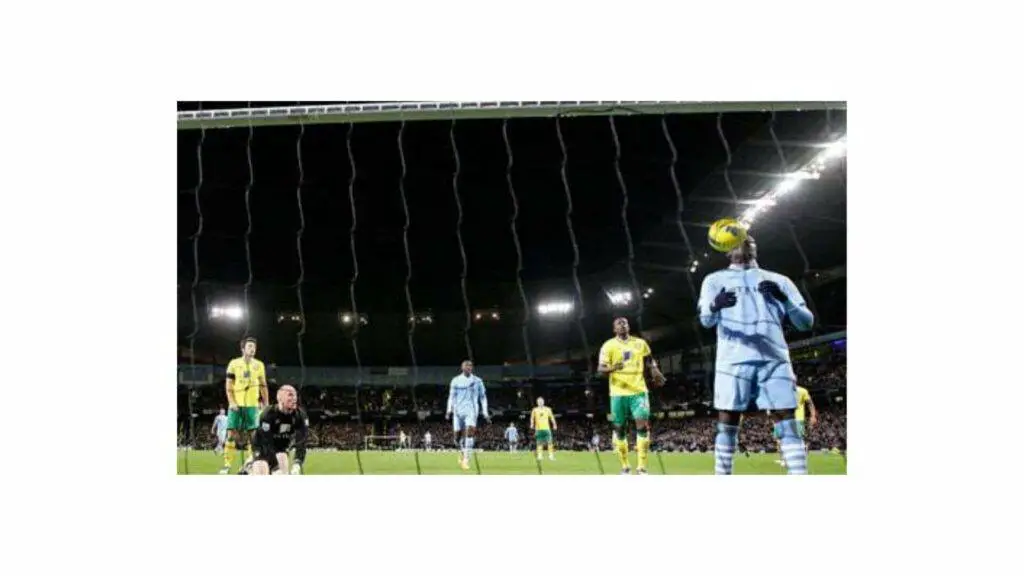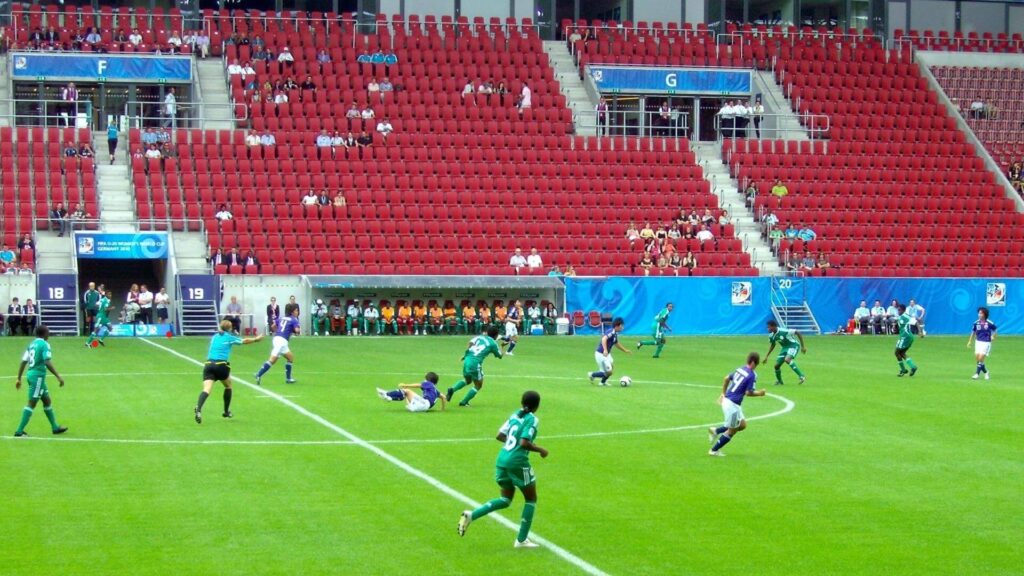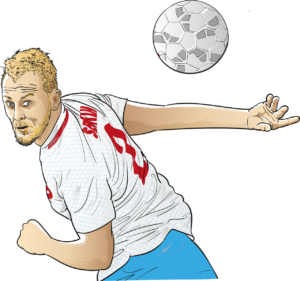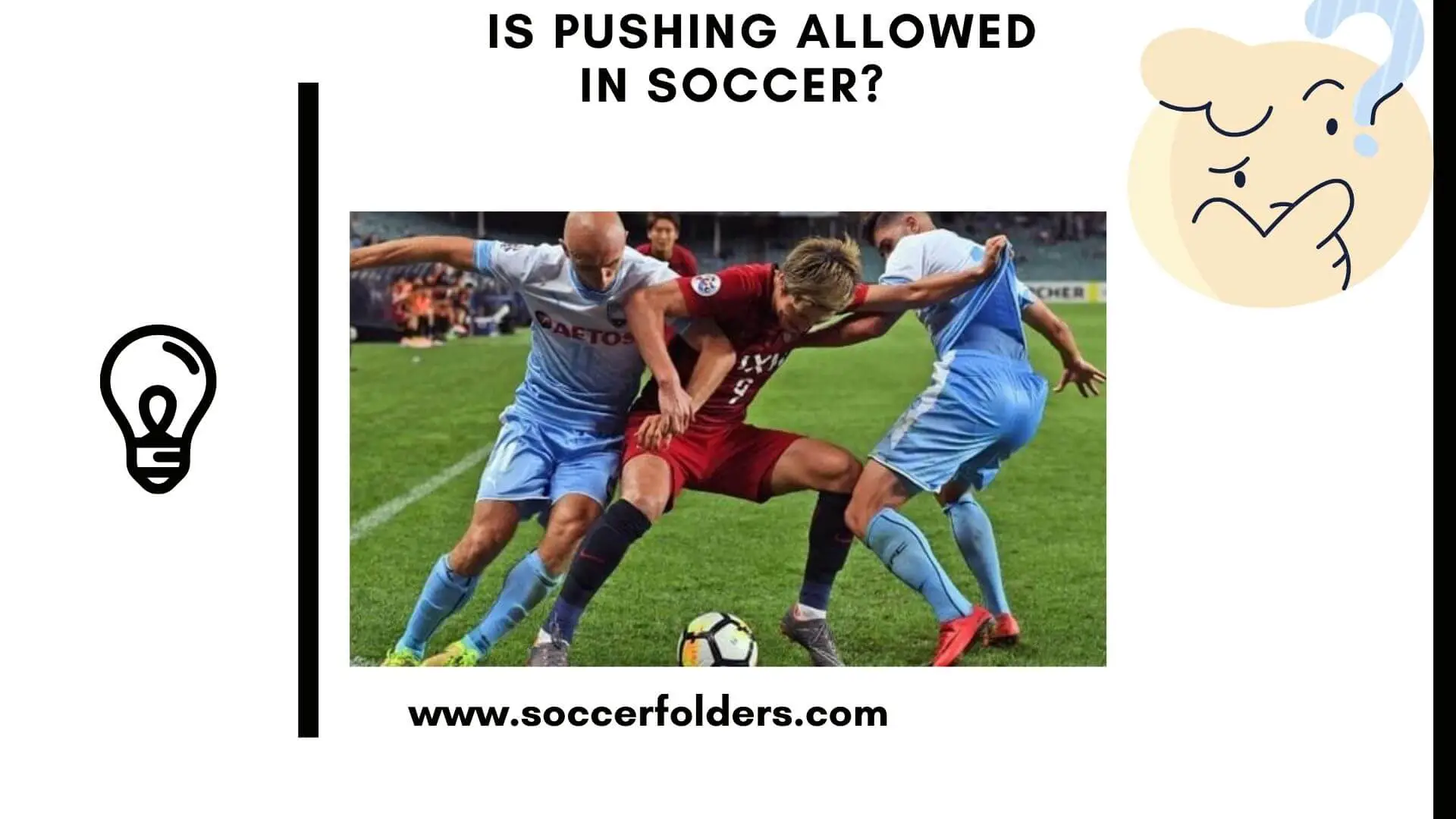Last Updated: July 4, 2023
Is pushing allowed in soccer/football?
Before answering that question, keep in mind that in soccer, football, or whatever you call it in your country, there tend to be a lot of fouls in a game, making the referee take a decision.
Those decisions occur after different types of fouls are committed.
Today, we are going to focus on pushing. Is pushing allowed in soccer, really? Pushing your opponent on the pitch, is it necessarily considered bad behaviour?
This is what you are going to find out in this article. Plus, you will also have an answer to other related questions people frequently ask.
Let’s get started.
Quick Navigation
- Is Pushing Allowed In Soccer?
- Is Shoulder Push Allowed in Football/Soccer?
- Can You Score A Goal With The Shoulder?
- Other Types of Fouls in Soccer
- Advantage Rule
- VAR (Video Assistant Referee)
- Dangerous Play
- Referee’s Discretion
- Player Suspensions and Disciplinary Actions
- Fair Play and Sportsmanship
- Interpretation of Rules
- Is Shirt Pulling Allowed In Soccer?
- Fair Charge In Soccer
- What Happens If A Soccer Player Touches The Ball With His Hands?
- What Can You Not Do In Soccer/On The Pitch?
- Final Thoughts
Is Pushing Allowed In Soccer?
Pushing is not allowed in soccer. It is considered a foul as it goes against fair play principles. Players are expected to use skills and tactics, not physical force, to gain possession of the ball.
Note that although some pushes are not strong enough to take a player down, it is still considered to be an anti-play as the offender is not trying to play the ball but preventing the opponent from getting to the ball.
However, is every push necessarily considered a foul in soccer? Let’s say you have mistakenly and slightly pushed an opposing player, will it be considered a foul by the referee?
Well, whether you are holding, pushing or pulling your adversary, no matter how slight it is, the referee will consider it a foul during a game. The rule is “Play the ball, not the man”.
Is Shoulder Push Allowed in Football/Soccer?
Shoulder-to-shoulder is absolutely allowed in football/soccer. When two players are struggling for the ball, it’s recommended to use the shoulders, this is legal and there is nothing wrong with that. However, shoulder push becomes a foul when the offender is pushing his opponent from the back and they are both not equally fighting for the ball.
Can You Score A Goal With The Shoulder?

If you were to score a goal with your shoulder during a soccer game, it would be allowed. As mentioned earlier in this article, the shoulder is a part of the body that all soccer players should take advantage of. Many soccer players have scored goals with their shoulders.
A great example can be read on planet football with Mario Balotelli’s shoulder goal.
Also, read “What is a finishing in soccer?”.
Other Types of Fouls in Soccer
Soccer involves various types of fouls that players can commit during a match.
These fouls include actions such as tripping, where a player intentionally causes another player to lose balance by obstructing their legs.
Kicking an opponent, whether it’s a deliberate kick or an accidental high kick that endangers the safety of others, is also considered a foul.
Elbowing, which involves striking an opponent with the elbow intentionally, and sliding tackles that are executed recklessly and can lead to injury are other examples of fouls in soccer.
Each type of foul has its own consequences, such as free kicks or penalty kicks being awarded to the opposing team.
Advantage Rule

In soccer, there is a rule called the advantage rule.
This rule allows the referee to let play continue, even if a foul has been committed, if the team that was fouled can benefit from the situation.
For example, if a player is fouled but manages to maintain possession of the ball and has a clear chance to score, the referee may choose not to stop the game and instead allow the attacking team to take advantage of the situation.
The advantage rule is applied to ensure that the flow of the game is not constantly interrupted and to give teams the opportunity to capitalize on advantageous positions.
This happens often in professional games, where we see a player running to face the goalie, and the defender trying to pull his shirt.
VAR (Video Assistant Referee)
VAR, which stands for Video Assistant Referee, is a technology used in soccer to assist the on-field referees in making certain decisions.
It involves the use of video footage and replays to review specific incidents during a match, such as goals, penalty decisions, red card offenses, or cases of mistaken identity.
The VAR system allows the referee to consult with a team of video officials who analyze the footage and provide additional information to help make more accurate decisions.
This technology aims to reduce errors in critical match-changing situations and ensure fair play.
This is important in case the referee has not seen a foul.
Dangerous Play
Dangerous play refers to actions on the soccer field that pose a risk of harm to other players.
These actions include high kicks or challenges where a player’s foot is raised at an excessive height near an opponent’s head, potentially causing injury.
Reckless tackles, where a player lunges into a challenge with excessive force or without regard for the safety of others, are also considered dangerous play.
The rules of soccer prohibit such actions to protect the well-being of all players involved and to promote a safe and fair sporting environment.
Referee’s Discretion
In soccer, the referee has the authority and discretion to interpret and apply the rules during a match.
Referees make decisions based on their judgment and assessment of the situation, taking into account the specific circumstances and context.
Referees may have slightly different interpretations of certain rules, and their decisions can influence the flow and outcome of the game.
For example, some referees may judge a push as a fair charge and others not.
Player Suspensions and Disciplinary Actions
When players accumulate yellow cards or receive red cards during a soccer match, they may face suspension and other disciplinary actions.
Yellow cards are shown by the referee as a caution, indicating that a player has committed a significant foul or displayed unsporting behaviour.
If a player receives multiple yellow cards in a tournament or league, they may be suspended for a certain number of matches.
Red cards, on the other hand, are shown for serious offenses such as violent conduct, deliberate fouls, or offensive language.
A red card results in immediate ejection from the game and can lead to additional match suspensions, depending on the severity of the offense.
So, if a player has already been booked in the game, they should be careful not to push or commit any other offence. Otherwise, they might be set off.
Fair Play and Sportsmanship
Fair play and sportsmanship are fundamental values in soccer.
Fair play refers to playing the game with integrity, respect, and adherence to the rules. It involves treating opponents, officials, and the game itself with fairness and honesty.
It is mentioned here because some players tend to overreact and try to fight with opponents’ players when they have been pushed.
So, sportsmanship encompasses displaying positive attitudes, demonstrating respect for opponents and officials, and accepting victories, defeats, and being fouled.
Fair play and sportsmanship are not only essential for maintaining a harmonious and enjoyable environment on the field but also for upholding the spirit of the game and promoting ethical behaviour among players.
Interpretation of Rules
The interpretation of rules in soccer/football can vary based on the referee’s judgment and understanding.
While the rules provide a framework for the game, there can be situations where the application of a rule requires the referee to make subjective decisions.
Factors such as the timing, context, and intent of an action may influence how a rule is interpreted and enforced.
Referees strive to apply the rules consistently and fairly, but there can be instances where different referees may have slightly different interpretations, leading to varying decisions in similar situations.
The interpretation of rules adds a human element to the game and contributes to the dynamic nature of soccer officiating.
Is Shirt Pulling Allowed In Soccer?
It is not allowed to pull a player’s shirt during a soccer game. In case you are pulling your opponent’s shirt during a game, a foul will be called by the referee and it might result in you receiving a yellow card. Sometimes, the referee may decide to let the game continue if and only if the ball holder is not destabilized. But when the ball is out, he will come back to you and give you a card.
If you are a defender and pull the opponent striker’s shirt in the box, even if it’s not enough to destabilize him/her, the referee might whistle a foul against you and award a penalty.
Why do some players pull shirts?
Well, this often happens when your opponent has been able to pick up speed on you. So, the best choice would be to pull his shirt before he reaches your box area.
You’ll probably take a card for that, but it’s a useful foul for the best of the team.
Also, remember, if you already have a yellow card, committing that foul(pulling, pushing or holding) will result in you having a red card.
So, if you are a defender, make sure to analyse each opposing striker before the game. Make sure to know their strengths and weaknesses and what they like to do with the ball. Knowing this will help you anticipate each moment during a game.
Also read, how to defend in soccer? This article will help you anticipate all the strikers’ moves, make sure you are always one step ahead of the game and avoid committing silly fouls as most defenders do.
Fair Charge In Soccer
In soccer, we refer to fair charge when two players are trying to get control of the ball from the same distance, with each player being stable standing and shoulder-to-shoulder.
If all those criteria are met and one player is taken down, a foul will not be called as it is a fair charge.
What Happens If A Soccer Player Touches The Ball With His Hands?
If a soccer player touches the ball on purpose with his hands during a game, a foul will be called and the offender is going to get a yellow card. If the ball hits his hands intentionally, the referee might decide to call a foul or not depending on the position of the hand.
For example, if the defender has his hand attached to his body and the ball hits this part of the body intentionally, there is no foul.
However, if the defender’s hand is detached from the body and the ball hits it, there is a clear foul.

By the way, read the full article about that here: Can you use your arms in soccer?
What Can You Not Do In Soccer/On The Pitch?
Here is a list of some of the things you can’t do in soccer:
- In soccer, you cannot touch the ball with your hands unless you are the goalkeeper or during a throw-in.
- You can’t spit on another player.
- You can’t punch your opponent.
- It’s not allowed to insult or push the referee.
- You can not fight in soccer.
- Don’t contest a referee’s decision.
Final Thoughts
Pushing your opponent is not allowed during a soccer game. It doesn’t matter whether it’s happening inside the box or outside.
However, a lot of players do it during games as a sacrifice for their team. They do it to prevent the opponent from creating a chance to score a goal.
However, a shoulder push is perfectly legal and allowed if both players are equally struggling for the ball. It is called shoulder to shoulder.
I hope you have gained value from this article about soccer pushing fouls.
What is your favourite type of foul? How often do you sacrifice for your team? Share your ideas and experiences in the comment section.



I enjoyed reading this blog. Learned so much from this! Keep on posting